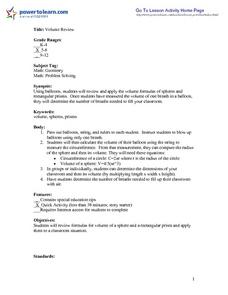NASA
Heavy Lifting
Accept NASA's challenge to design heavy lifting vehicles. Groups of three design balloon-powered rockets to carry as much payload to the ceiling as possible. The teams are encouraged to launch several times while making improvements to...
NASA
Make a Planetary Exploration Balloon
Balloons aren't just for parties! An inquiry-based lesson explores the idea of using balloons for space exploration. Learners become engineers as they attempt to control the ascent and descent of a helium balloon using different masses.
Museum of Science
Balloon Racers
Watch those balloon cars go! Scholars build racers that run using the power of balloons and conduct races with the cars. They learn about Newton's third law of motion and how it applies to their balloon racers.
Museum of Science
Static Cling
Cling to a lesson on static electricity. Pupils take part in experiments where they see how paper from hole punchers, packing peanuts, puffed rice cereal, and other items react when placed near a rubbed balloon. They learn how electrons...
Museum of Science
Fingerprints
Capture your unique print. Individuals ink a finger and create a print on a deflated balloon. By blowing up the balloon, pupils get a magnified view of their unique print. They see if they can identify any loops, whorls, and arches in...
DiscoverE
Pilot a Balloon
Balloons will go where you want them to. Young pilots first add paper clips to a balloon to make it neutrally buoyant. They then use cardboard to steer the balloon in different directions, taking air pressure into account.
Concord Consortium
Sticking a Balloon to a Wall
This is one sticky situation! Science sleuths uncover the mystery behind a balloon that appears to be stuck to a wall using an interactive. Learners observe a neutrally charged wall before they manipulate the charge on a balloon. Atom...
Space Awareness
Water is a Heat Sink
One of the key objectives of Europe's Copernicus Earth program is to monitor the temperatures of the oceans and seas on Earth. Young scholars learn the effects of different heat capacities through two experiments. These experiments...
Dr. Seuss Enterprises
Read Across America
Celebrate the whimsical world of Dr. Seuss on Read Across America Day with a collection of science, technology, engineering, the arts, and mathematics activities, each linked to a popular Dr. Seuss story.
Teach Engineering
Preconditioning Balloons: Viscoelastic Biomedical Experiments
What does stretching a balloon have to do with equilibrium? Groups explore preconditioning by stretching a balloon to a point of equilibrium. They then measure the amount of force required to stretch the balloon to the same point several...
Houghton Mifflin Harcourt
Balloons Over Broadway Activity Kit
After reading the book Balloons Over Broadway about the incredible puppeteer who created the first Macy's larger-than-life parade balloons, your youngsters will celebrate their reading by participating in a variety of engaging activities...
Curated OER
Warm and Cold Air
Students conduct an experiment to discover what happens to air when it is heated or cooled, discover that wind moves from a high-pressure area (an area of sinking air) to a low pressure area (an area of rising air).
Curated OER
Balloon Math: A Game for All Levels
Here is a game that combines exercise with math skills. In this mathematics and P.E. lesson, students hold balloons that have a number written on them, and for a set time do not let the balloons hit the ground. They must catch a balloon...
Curated OER
Balloon Dance
Young learners love creative movement. Here is a lesson that allows them to imitate balloons floating away by doing a "Balloon Dance." They start on the ground as if they are flat balloons with no air in them. The music starts, and they...
Curated OER
Up & Away
Students research where balloons go when they fly away, the consequences of their escape, and suggest alternative possibilities for preventing balloon escapes in real life. They identify humorous stories and discuss the qualities that...
Curated OER
Volume Review
Learners investigate the concepts of volume for rectangular prisms and spheres. They measure the volume of one balloon and then consider how many breaths it would take to fill the room with balloons. The rectangular prism being measured...
Curated OER
Mathematical Balloon Pop
First graders study addition and subtraction. In this mathematics and physical education lesson, 1st graders pop balloons and solve math sentences involving addition and subtraction inside each balloon.
Curated OER
Hot Air Ballooning: Exploring Charles' Law
Students solve word problems dealing with Charles' Law. In this Charles' Law instructional activity, students observe PowerPoint presentations concerning Charles' Law. They complete a WebQuest and describe the relationship between hot...
Curated OER
Gases Lighter and Heavier than Air
Learners explore the concept of air density. In this air density lesson plan, students fill balloons with helium and carbon dioxide. Learners determine which gases are heavier or lighter than air.
Curated OER
Balloon Fun
Pupils conduct an experiment with balloons and skewers. They speculate the reasons for the balloon's reactions to the skewers and write about their observations.
Curated OER
Children's Literature Across the Curriculum Ideas-Harvey Potter's Balloon Farm
Students read Harvey Potter's Balloon Farm by Jerdine Nolen Harold. They complete a variety of cross-curricular activities surrounding the study of balloons. Included are reading, art, math, science, writing, social studies, and library...
Curated OER
Balloons
Students explore the different types of balloons. In this materials lesson students can complete several experiments including building their own hot air balloons, making balloon animals and experimenting with static electricity.
Curated OER
What Makes a Rocket Shoot Upward Into the Air?
Young scholars collect data of balloons of different sizes to see which one travels the furthest when shot into the air to represent a rocket. In this rocket lesson plan, students write about which balloon traveled the furthest and why.
Curated OER
Positive and Negative Charge Using Balloons
Fourth graders observe and explain how balloons rubbed on a shirt create positive and negative charges. In this positive and negative charge lesson plan, 4th graders record their results and explain their findings.

























